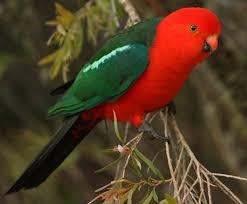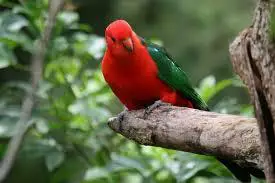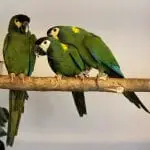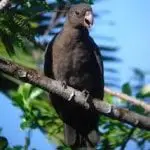Scientific facts
| Scientific name | Alisterus scapularis |
| Mass | 230 g (Adult) |
| Family | Psittaculidae |
| Order | Psittaciformes |
Description
Adults of equal sexes are around 43 cm (17 in) in measurement, counting the long, comprehensive tail. The mature male has a red cranium, breast, and lower bottoms, with a cobalt band on the posterior of the neck amid the red above besides jade on the backbone, the wings are lime, and each has a light jade shoulder band, the end is green, besides the rump is azure. The male has a reddish-ginger upper jaw with a dark tip, a dark lower jawbone with a carroty base, and creamy irises. The down of the female is very dissimilar from the male having a jade cranium and breast, a grey beak; then, the light shoulder band is minor or absent. Youngsters of equal sexes have russet irises and a yellowish beak, besides otherwise look like the female.
The 2 categories are A. s. minor originated at the northern boundary of the type range and is alike in arrival to the nominate category but slighter, characteristically about 5 cm (2 in) smaller in measurement.
On those infrequent individuals who take parts without melanin, fluffs are carroty to yellow. Such a fowl can guise is startingly diverse from the more shared crimson and green diversity.
Distribution and Taxonomy
Australian king parrot’s variety from the north and dominant Queensland to southern Victoria. They are often seen in small clusters with numerous types of rosella. Additional from their standard eastern upland home, they are also originated in Canberra throughout winter, the outer western conurbations and north coast of Sydney, and the Carnarvon Gorge in dominant Queensland.
Aviculture
In their innate Australia, king parrots are infrequently bred in birdcages and reserved as calm and comparatively noiseless household animals if hand-raised. They incline to be discerning in their excellent of kernels they eat and incline not to swallow small kernels in pre-packaged trade bags. They are comparatively unidentified outside Australia. As a domesticated animal, they have incomplete “talking” aptitude and normally favor not to be touched; nonetheless, they do bond willingly to people besides can be very enthusiastic. Life expectation in the wild is unidentified; nonetheless, some pets have been recognized to animate up to 25 years.
Australian King Parrot General Info
The Australian King Parrot is a general pet in its home, and its admiration has been progressively increasing all over the world. Cheers to their calm character, great intellect, and their sole, lively look, they are a sought-after type. These big parrots have many bizarre makings that make them wanted in the pet marketplace, and with their luminously colored plumage, they leave a permanent imprint. Besides the requirement for a great deal of space, these are laidback to care for. With all these countless traits and regal looks, there’s no miracle they are named the “king” parrots.
Speech and Sounds
A lot of unusual parrots from Australia besides New Guinea are often loud and unbearable to keep in a room. The case is diverse from the Australian King Parrot. Even though they have a lurid natural noise, these loud squawks and cheeps are not heard very frequently. Furthermore, content and fit pet that isn’t deserted will tend to be silent and calm. To wader, the Australian King Parrot can frequently learn a small number of simple words to recurrence; nonetheless, they aren’t truly speaking birds.
Colors
As soon as you see an Australian King Parrot, it will be hard to fight their attractiveness.
In Australia’s pet parrot marketplace, which is frequently conquered by simply colored Cockatoos, a fowl with an interesting fluff is a comfortable sight. And the Australian King Parrot certainly turns that bill! With its striking insignias and bright differences, this bird certainly stands out. The males are frequently lively, orange-red. The wings are deep forestry jade, with a thin turquoise band in the central. The posterior is purple, getting dimmer on the tail fluffs. The base of the end shows 4 mixed strips of purple and pink.
The females are typically lime, with lighter qualities on the torso. The wings are arresting bright jade and slowly getting stronger on end. The stomach and thighs are carroty. The underside of the tail displays a combination of red and lime strips. With these superb particulars and rich, unusual colors, we can say that these truly are King parrots – kings of loveliness and attraction!
Care and Feeding
In the desolate, these parrots consume very rich food that is complete up from numerous fruits, berries, nuts, plants, kernels, insects, and sprouts. To re-form this régime and offer your Australian King Parrot a balanced consumption of proteins and nutrients, you must start with a small kernel mix that comprises the significant canary, oats, safflower, then hemp seeds. You must also comprise fruits, for example, apples, pears, bananas, besides oranges, along with some common nuts. A well-balanced food will indorse good fitness.
Personality & Behavior
The Australian King Parrot is painstaking to be an outgoing and calm domesticated, especially if they are hand-raised. Passive and friendly, they make great friends, and they incline to make sturdy pledges with their owners as time permits. They are too amusing and dear to play with figurines. You’ll be astonished at their acumen, and their tricks will put a beam on your face. Overall, these birds might be slightly infrequent in the market; nevertheless, they do take all the characters of a delightful pet parrot. The Australian King Parrot fixes well in a flat (provided that there’s sufficient space), family, with relations, seniors, besides singles. Their adaptability is just an additional great class!
Fun Facts
- There are about 372 diverse parrot classes.
- Most parrots animate in tropical parts.
- Parrots have bent bills (beaks), robust legs and scraped feet.
- Parrots are frequently brightly tinted.
- Parrots are supposed to be one of the brainiest bird types.
- Some types are identified for copying human speeches.
- Most parrot types trust on seeds as nourishment. Others might consume fruit, nectar, plants, or minor insects.
- Parrots, for example, the budgerigar (budgie) besides cockatiel, are general as pets.
- Some parrot types can animate for over 80 years.
- There are 21 diverse types of cockatoo.
- Cockatoos frequently have dark, grey, or white fluff (feathers).
- New Zealand is home-based to some actual exclusive parrots counting the kea, kaka besides kakapo.
- Keas are big, smart parrots that live in alpine zones of New Zealand’s South Island. They are the world’s lone alpine parrot and are recognized for their inquisitive and from time to time, cheeky conduct near ski areas where they like to examine bags, bargain small matters, and damage carriages.
- Kakapos are disapprovingly rare nonflying parrots; as of 2010, only about 130 are identified to exist. They are vigorous in the evening (nocturnal) and fodder on a choice of seeds, fruit, florae, and pollen. Kakapos are too the world’s weightiest parrot.
- The flag of Dominica landscapes the sisserou parrot.
Common Health Issues
Aspergillus. This is a fungiform contagion of parrots’ air sacs besides lungs, typically contracted in dank or dirty surroundings where the mold can bloom. The indications are breathing problems, with perceptible wheezing, escorted by fluffed-up plumages, and a usually ‘poorly’ entrance. There is occasionally emancipation from the nostrils.
Avian Gastric Yeast (AGY) contagion (Wasting Disease). Also identified as macrorhabdiosis, or megabacteriosis, this highly transmissible contagion is caused by a combination of yeast contagion and subordinate bacterial contagion. It distresses budgies mostly. It is hard to spot in the early phases, incubating with no external sign of distress. The first external sign is weight loss, as AGY obstructs ingestion. There will be undigested nourishment in the mucks, and birds may bile food and secretion.
Candida virus (Thrush), or Candidiasis. This is a yeast contagion, the similar one that infects people. It blooms in the parrot’s yield or gastral tract, and will not be conveyed to humans via animals except you let them to ‘kiss’ you (an ill-counseled ‘trick’ that some holders like to teach their natures). Diseased birds will be languid and might have loose mucks. As these are indications of many types of illness, a trip to the vet for analysis is vital. Candida is easily curable.
Colds, Sneezes. Parrots can have colds (though the diseases are diverse to that which contaminates humans), and the indications are comparable – runny noses, distended eyes, puffed, and sneezing. In parrots, though, the disorder can lead to fast weakening, and a vet’s managements will be obligatory.
Macaw Wasting Syndrome, or Proventricular Dilatation syndrome. This is a virus-related infection that grounds stomach difficulties; Diseased birds will have an augmented appetite; nevertheless, they will weight loss besides passing undigested nourishment in their mucks. There may be sickness too. There is a fast weakening in health, conclusion in demise if not treated. It is not limited to macaws; nonetheless, it cannot be conveyed to humans. Deterrence via unvarying and full birdcage cleaning is the best method, as an ill bird is improbable to live, and a vet will usually endorse euthanasia.
Nutritional Deficiencies
The indications of a poor diet are diverse, from plume loss and beak deformity to behavioral difficulties and a fast weakening into death. All pet birds want their suggested daily quantities of vitamins and minerals, along with protein, fatty acids, besides numerous micronutrients. A balanced régime and admittance to a mineral block should source all these requirements.
An absence of calcium will chief to Hypocalcaemia. This causes precise difficulties in female birds if they are placing eggs. They might turn out to be egg-bound, or the ovum might be soft-shelled and impracticable. An affected fowl may turn out to be infertile. To absorb the calcium, the parrot wants a good vitamin source too – a healthy food and mineral block must provide all the fowl requirements.
Associated with nutritional difficulties are obesity-related matters. This is continuously due to extra fat besides sugars in the bird’s régime. Nourishing each type with the exact supplies for that type is the answer, while things can convert a bit more complex in aviaries where one fowl consumes the whole cage’s source of preferred fatty nourishment or obtains a taste for something not usually comprised in that species’ food. Keeping an eye on your birds’ conduct will give you signs of what’s going on, besides in worst-case situations you might have to separate the avaricious one.
Parrot Fever, or Psittacosis
This is the nastiest thing that can raid your aviary. It feasts very rapidly, and most of the affected birds will perish. The organism accountable is Chlamydophia psittaci, a type of the chlamydia family of microorganisms. In birds, the illness is named ornithosis, and in parrots has the exact designation psittacosis. One of the principal glitches is that it can live in the setting in soil or mucks, keeping a clean birdcage or birdhouse is consequently indispensable, and the best preemptive action. If contagion strikes, sterilizing the atmosphere is necessary – opposite actions are gamely obtainable from vets.
The detail is, the world is filled with chlamydia bacteria. About 1% of the rough bird populace is supposed to carry it, and its company in their mucks is the usual source of an eruption in an aviary. Numerous of these desolate birds are transporters, with no outside indications of the disease. It inclines to flare up under pressure – another disease, dearth, poor food source, isolation, or re-housing, for instance – and feasts via the air concluded plume and fecal powder (‘dander’). A diseased bird will have diseased mucks up to 2 weeks before showing signs of disease. Isolation of any new bird is consequently important for at least 45 days.
Indications vary rendering to types. Conjunctivitis and other signs of painful or distended eyes are a clue (though this may be because of other contagions, note). If the problem is psittacosis, the disorder won’t retort to conventional conduct. In over-all, the image of being ‘sick as a parrot’ sums up the indications – generally lively birds convert reserved, with disheveled feathers, loss of hunger, fast weight loss, loose mucks (frequently bright avocado) and breathing difficulties (counting nasal emancipation besides coughing/sneezing). Some birds weakening very rapidly and perish within 24 hours.
If a fowl displays any of these indications, separate it instantly and consult a vet. Analysis through examinations is astonishingly hard, as the chlamydia bacteria are usually current in such numerous birds in a dormant national. Exclusive online information site for parrots brands the grim remark: “Post-mortem inspection is maybe the most dependable technique of achieving a positive analysis”! But a post-mortem will as a minimum let you distinguish if your other birds are in hazard (i.e., if one parrot has the illness, the others are perhaps infected).
A vet might endorse putting an infected parrot to slumber because the illness is so hard to remove, and also the possible danger to human health. This is continuously a quandary; nonetheless, human health thoughts must take importance.
Polyoma. This disease is the main source of anxiety in baby parrots, producing a high proportion of deaths. In grownup birds, the disease is curable with antibiotics. Indications in mature birds are intestinal – loose mucks and sickness. Newer birds will have distended stomachs, tremors, and feather glitches. Polyoma is not communicable to humans. Birds can be inoculated against it – far and away from the unquestionable deterrence.
Psittacine Beak and Feather Disease (PBFD). This is an irredeemable disorder caused by Psittacine circovirus. Its bouts feather sacs, causing fluffs to become underdeveloped and misshapen. Over the period, they will drop out. The illness is not life intimidating in itself but can reason the resistant system to become dejected, making the birdie vulnerable to secondary contagion. An affected fowl will need extra warmth, and will guise like a huge, reptilian parrot chick. Cockatoos, besides cockatiels, are chiefly vulnerable. Unfortunately, there is still no treatment.
Sour Crop. The crop is a share of a bird’s gastral system, and it can develop diseased by microorganisms or candida yeasts. ‘Sour crop’ is a general for crop-related difficulties. The indications will be a distended crop area, vomiting, and lethargy. A vet’s knowhow will be obligatory to pinpoint the problem and bid a cure.
Ulcerative dermatitis. This is a skin complaint connecting ulcerated casing. It might be due to preceding wounds or breakings, diabetes, or colonic parasites. The ulcers are produced by the painful parrot pecking its covering. The wounds become prickly, creating a spiteful circle. Once the wound is open, microbial or fungal contagions can cause difficulties. Cleaning and vet-prearranged antibiotics are the treatment. Parrots might have to wear a collar, whereas the wound rectifies.

Care Sheet
Choosing a Cage
When selecting a birdcage, you need to make certain the bar arrangement is suitable for the scope of parrot you are going to retain. Cockatiels and any types smaller than that need ½ inch bar arrangement; bigger ones want ¾ inch, and big parrots must be specified cages with 1-inch space. The aim is less to do with ascending issues, and further about parrots getting their heads fixed. If the fowl can crush its cranium between the bars, it will.
Numerous parrots like to hike, so level bars are a necessity for them.
Being brainy and nosy birds, parrots can soon get uninterested. The birdcage needs to have sufficiently of diversity, from dissimilar types of roost and climbing devices to a rotation of ever-changing dolls. The additional space you can deliver, the better.
Parrot Pellets
Contingent on the type you retain, a formulated pellet-based parrot combination will form 40-75% of the bird’s day-to-day food. The brand you select needs to be of the uppermost quality if your parrot is to animate long and look upright. The finest combinations are carbon-based and made with elements fit for human feasting. Seasonings should be evaded (except it’s something nutritionally indispensable, for example, calcium or vitamin K). In the barren, a parrot contracts all its nourishment from natural nutriments, and that state can be replicated at home. All combinations will brand bold rights about how decent the content is, nonetheless bear in mind that parrot nourishment is not as tightly controlled as human nutrition.
Meat and Live Food
One peep at a parrot’s beak will tell you that it is chiefly a kernel and nut eater. Having supposed that, some parrots obtain a taste for live nourishment; nonetheless, others fly to the additional side of the birdcage to evade it.
Parrots are not actual omnivorous in the rough (with the exclusion of New Zealand’s Kea, which is not accessible in the pet craft), and meat does not take to be encompassed in their régime. Some owners bid it as a treat, nonetheless it is positively not essential, and should only be specified infrequently, and in small quantities (a few scraps on a bone, for instance).
Roosts for Large Parrots
Macaws and other big species will need robust twigs rather than sticks. Any fowl reserved for long stages outside the birdcage will need an external roost too – the kind of object you see in menageries or bigger pet shops. You can brand one of these yourself, though several pet dealers vend them to make your life relaxed. Numerous of these roosts come with nourishment and water container fittings, with a waste tray underneath to catch all the muddle.

Availability and where to get
You will be able to find such kinds of birds from local pet shops. Since they are not extinct, you can still find them in your local pet shops, especially in those specialized avian pet stores. You can also ask your avian vet for referrals.
FAQ Section
How many offspring do king parrots lay?
The King Parrot hen frequently places three to six eggs in respectively clutch, which she gestates for around 20 days.
What food do king parrots consume?
King parrot fodder on kernels, fruit, berries, nuts, nectar, flowers, leaf sprouts, insects than their larvae. Stones of eucalypts, angophoras besides acacias make up a main amount of the food, and these are obtained mostly in the vegetations and bushes. The breeding period persists from September to January.



